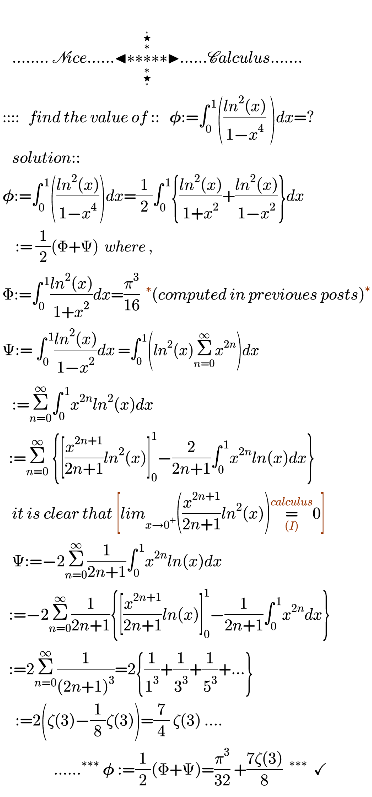
Question and Answers Forum
DifferentiationQuestion and Answers: Page 20





|
Question and Answers Forum |
DifferentiationQuestion and Answers: Page 20 |
| The maximum value of y=(√((x−3)^2 +(x^2 −2)^2 ))−(√(x^2 +(x−1)^2 )) is |

|
| .......nice ......integral...... 𝛗:=∫_(0 ) ^( 1) ((li_2 (1−x))/(2−x)) dx=?? .......m.n... |
| ....... discrete ..... mathematics....... prove that: Σ_(n=1) ^∞ (1/(F_(2n+1) −1))=^? ((5−(√5))/2) F_n :: fibonacci sequence... |
| Prove that ∀n∈N^∗ Π_(k=1) ^(n−1) sin(((kπ)/(2n))) = Π_(k=1) ^(n−1) cos(((kπ)/(2n))) |
| prove that :: 𝛗:=∫_0 ^( ∞) ((ln(1+cos(x)))/(1+e^( x) ))dx=0 ................ |
| evaluate..... Σ_(n=1) ^∞ (((n.cos(nπ))/(Γ (2n+2))))=? ..... ....... |
| if 𝛗 (q):= ∫_1 ^( ∞) (1/( (√x) (q+x)^x ))dx then :: lim _(q→1) 𝛗(q):=? |
| (dy/dx) y= 3a^x −cot 2x |
| Σ_(n=0) ^∞ ((ζ(2n+2)(−1)^n )/4^n )=? |
| Nice...≽≽≽∗∗∗≼≼≼...Calculus Ω:=∫_0 ^( 1) (((1−(x)^(1/3) )(1−((x ))^(1/5) )(1−(x)^(1/7) ))/(ln( ((x ))^(1/3) ))) dx=? ....m.n |
| .......Advanced ...∗∗∗∗∗ ...Integral...... Prove that :: Φ :=∫_0 ^( 1) ((1−x)/((1−x+x^2 )log(x)))dx= proof:: Φ:=∫_0 ^( 1) ((1−x^2 )/((1−x^3 )log(x)))dx f (a):= ∫_0 ^( 1) ((1−x^a )/((1−x^3 )log(x))) Φ := f (2) ........✓ f ′(a):=∫_0 ^( 1) ((−x^a log(x))/((1−x^3 )log(x)))=∫_0 ^( 1) ((−x^a )/(1−x^3 ))dx (★) (★):: x^3 =y ⇒ f ′(a):=(1/3)∫_0 ^( 1) ((y^((−2)/3) −y^((a/3)−(2/3)) )/(1−y))dy :=(1/3)∫_0 ^( 1) ((y^((−2)/3) −1+1−y^((a/3)−(1/3)) )/(1−y))dy :=(1/3)(ψ((a/3)+(2/3))−ψ((2/3))) f (a):=log(Γ((a/3)+(2/3)))−(a/3)ψ((2/3))+C f (0):=0=log(Γ((2/3)))+C C :=−log(Γ((2/3))) Φ:= f (2)=log(Γ((4/3)))−(2/3) ψ((2/3))−log(Γ((2/3))) :=log(((Γ((4/3)))/(Γ((2/3)))))−(2/3)ψ((2/3)) ....✓ |
| ∫(e^x /(cosx))dx |
| Ω:=∫_0 ^( 1) (((√(1−x)) arcsin(x))/( (√(1+x))))dx=?? |
| prove that:: I:=∫_0 ^( (π/2)) arccosh(sin(x)+cos(x))dx=(π/2)ln(2) .. |

|

|
| (x^2 lnx)y′′−xy′+y=0 |
| .......Advanced ...★ ...★ ... Calculus....... if Ω =Σ_(n=2) ^∞ (((−1)^n ζ(n))/2^n ) then prove that :: (1/2) = e^(Ω−1) proof :: method (1): ψ (1+x )= −γ+Σ_(n=2) ^∞ (−1)^n ζ(n)x^(n−1) ( Maclaurin series for ψ(x+1) ) x:=(1/2) ⇒ ψ ((3/2) )=−γ + 2Σ_(n=2) ^∞ (((−1)^n ζ(n))/2^n ) (∗ ) we know that :: ψ(1+x)=(1/x)+ψ(x) ( ∗ ) ⇛ ψ ((3/2))=2+ψ((1/2))=−γ+2Σ_(n=2) ^∞ (((−1)^n ζ(n))/2^n ) (∗) ⇛ 2−γ−ln(4)=−γ+2Σ_(n=2) ^∞ (((−1)^n ζ(n))/2^n ) ln((e/2))= Σ_(n=2) ^∞ (((−1)^n ζ(n))/2^n ) =Ω (1/2) = e^(Ω −1) ....✓ ...m.n.july.1970... |
| Σ_(n=1 ) ^∞ ((sin((((2n−1)π)/6)))/((2n−1)^2 )) = a.G a = ? (G:= catalan constant) |
| Find the smallest value of (√(x^2 +y^2 )) among all values of x & y satisfying 3x−y = 20 |

|

|
| ......advanced........calculus....... prove that:: ξ:=Π_(n=2) ^∞ e(1−(1/n^2 ))^n^2 =(π/(e(√e))) |
| ......nice ......calculuus..... prove that:: 𝛗:=∫_0 ^( ∞) ∫_0 ^( ∞) ((A rctan(x^2 y^2 ))/(x^4 +y^4 ))dxdy=((π^2 (√2))/(16)) ..... |
| A closed cylindrical can be is to hold 1 liters of liquid . How should we choose the height and radius to minimize the amount of material needed to manufacture the can ? |